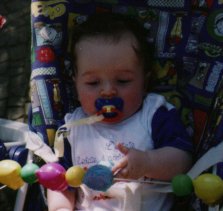Other important details
1. Observe your child noticing hand movements and developing eye-hand co-ordination.
 |
 |
 |
2. Notice changes in the alignment of the eyes. Sometimes both eyes may be looking at you, sometimes one of the eyes may turn in, as in this case the left eye, or out. |
3. If one of the eyes has become a lazy eye, follow the instructions of your paediatric ophthalmologist about the use of glasses and patching, sometimes also drops. In this case the left eye is the lazy eye, the right eye's glas is partially covered all the time and completely covered during short intensive play situations a few times a day. |
 |
The patch on the lens may also be translucent half or full cover. If full cover of a lens is used, then it is important that the infant/child does not look over the frame. If that occurs, full occlusion with a patch is necessary to force the infant to use the lazy eye. It is then important that the lazy eye has high quality visual information for training - and it must be sure that the eye or the optic nerve are not damaged so badly that training will not improve function.
[ Info for Parents ] [ Paediatric Vision Tests ] [ My Sight is Important! ]
Edited in July 2009.